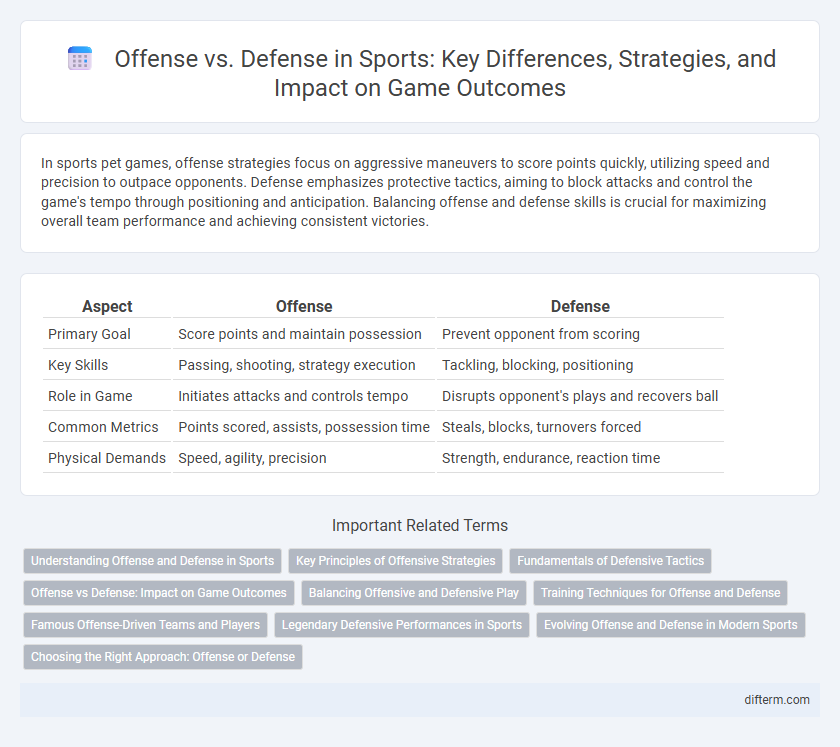In sports pet games, offense strategies focus on aggressive maneuvers to score points quickly, utilizing speed and precision to outpace opponents. Defense emphasizes protective tactics, aiming to block attacks and control the game's tempo through positioning and anticipation. Balancing offense and defense skills is crucial for maximizing overall team performance and achieving consistent victories.
Table of Comparison
| Aspect | Offense | Defense |
|---|---|---|
| Primary Goal | Score points and maintain possession | Prevent opponent from scoring |
| Key Skills | Passing, shooting, strategy execution | Tackling, blocking, positioning |
| Role in Game | Initiates attacks and controls tempo | Disrupts opponent's plays and recovers ball |
| Common Metrics | Points scored, assists, possession time | Steals, blocks, turnovers forced |
| Physical Demands | Speed, agility, precision | Strength, endurance, reaction time |
Understanding Offense and Defense in Sports
Offense and defense in sports represent two fundamental strategies where offense focuses on scoring points or goals by advancing the ball or puck and creating scoring opportunities, while defense aims to prevent the opposition from scoring through tactics like marking, blocking, and intercepting. Understanding offensive tactics involves analyzing player positioning, ball control, and set plays to exploit weaknesses in the opposing defense. Defensive strategies rely on spatial awareness, teamwork, and adaptability to disrupt offensive plays and regain possession effectively.
Key Principles of Offensive Strategies
Effective offensive strategies in sports emphasize ball control, spacing, and dynamic movement to create scoring opportunities. Prioritizing quick decision-making and exploiting defensive weaknesses enhances the ability to penetrate and destabilize opposing defenses. Mastery of timing and coordinated teamwork increases offensive efficiency and pressure on defenders.
Fundamentals of Defensive Tactics
Fundamentals of defensive tactics emphasize positioning, anticipation, and communication to disrupt the opponent's offensive strategies effectively. Key skills include maintaining a strong defensive stance, reading the opponent's movements, and coordinating with teammates to cover gaps and limit scoring opportunities. Mastering these basics enables a cohesive defense that minimizes risks and controls game tempo.
Offense vs Defense: Impact on Game Outcomes
Offense drives scoring opportunities and directly influences the pace and momentum of the game, with high-scoring teams often dominating possession and putting constant pressure on opponents. Defense plays a critical role in limiting scoring chances, forcing turnovers, and controlling the game's flow by disrupting offensive strategies. Balanced teams that excel in both offensive production and defensive resilience tend to achieve more consistent winning outcomes in competitive sports.
Balancing Offensive and Defensive Play
Balancing offensive and defensive play is crucial for team success, as it ensures effective scoring opportunities while minimizing opponent breakthroughs. Teams that integrate quick transitions, strategic positioning, and adaptive tactics maintain control over both attacking and defensive phases. Optimizing player roles based on situational demands enhances overall performance and sustainability throughout the game.
Training Techniques for Offense and Defense
Effective training techniques for offense emphasize agility drills, precision passing, and situational awareness to enhance scoring opportunities. Defensive training prioritizes strength conditioning, spatial positioning, and reaction speed to disrupt opponents and prevent scoring. Integrating video analysis and simulated game scenarios optimizes both offensive and defensive skill development.
Famous Offense-Driven Teams and Players
Famous offense-driven teams like the 2013 Denver Broncos, led by Peyton Manning, revolutionized scoring with record-breaking passing yards and touchdowns. Players such as Michael Jordan in basketball and Lionel Messi in soccer are renowned for their extraordinary offensive skills, consistently generating high points and goals. These teams and individuals emphasize aggressive attacking strategies that dominate games through dynamic plays and relentless scoring pressure.
Legendary Defensive Performances in Sports
Legendary defensive performances in sports often define championship legacies, with athletes like Bill Russell anchoring the Boston Celtics' dominance through unmatched shot-blocking and rebounding during the 1960s NBA Finals. Defensive strategies, such as the impenetrable zone defense employed by the 1985 Chicago Bears, revolutionized football by disrupting offensive plays and causing turnovers that led to Super Bowl XX victory. These iconic defensive displays highlight the critical role of anticipation, positioning, and teamwork in halting opponents' scoring opportunities across basketball, football, and other competitive sports.
Evolving Offense and Defense in Modern Sports
Modern sports showcase rapidly evolving offense and defense strategies driven by advanced analytics and technology integration. Offenses prioritize dynamic playmaking and spatial exploitation, while defenses adapt with real-time data analysis and flexible formations to counteract diverse attack patterns. This continuous arms race elevates overall gameplay complexity and spectator engagement.
Choosing the Right Approach: Offense or Defense
Selecting the appropriate strategy in sports hinges on analyzing team strengths and opponent weaknesses to determine whether an offensive or defensive approach maximizes chances of victory. Teams with strong attacking players often benefit from an aggressive offense, leveraging rapid ball movement and high-pressure tactics to control the game tempo. Conversely, a defensive approach prioritizes structured positioning, resilience, and counterattacks, which are critical against highly skilled opponents or in scenarios requiring game control and minimizing risk.
offense vs defense Infographic

 difterm.com
difterm.com